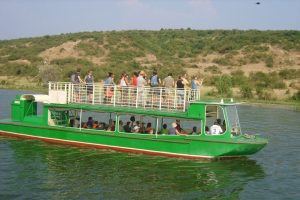Overlanding from Rwanda to Uganda is one of the most rewarding ways to experience East Africa. The journey takes travelers through rolling hills, scenic landscapes, lively border towns, and bustling highways that connect two of the region’s most vibrant countries. Whether you are driving your own vehicle, taking a bus, or traveling with an overland tour operator, this route combines adventure with cultural immersion. In this guide, you will find everything you need to know about crossing from Rwanda into Uganda by road, including border procedures, road conditions, safety, costs, and the most frequently asked questions travelers search for online. Overlanding from Rwanda to Uganda
What documents do I need to cross from Rwanda to Uganda by road?
To cross the Rwanda–Uganda border by road, travelers must carry the following essential documents:
- Passport: A valid passport with at least six months before expiry.
- Visa: Depending on nationality, visitors can apply for a Ugandan visa online, purchase one on arrival, or use the East Africa Tourist Visa (valid for Kenya, Uganda, and Rwanda).
- Yellow Fever Certificate: Proof of Yellow Fever vaccination is mandatory and often checked at border points.
- Vehicle documents (if self-driving): Valid driving license, vehicle logbook or proof of ownership, COMESA Yellow Card insurance (valid across multiple African countries), and temporary import permit if applicable.
Carrying copies of important documents is recommended, as some border posts may request duplicate forms.
Which border crossing is best between Rwanda and Uganda?
Several border crossings link Rwanda and Uganda, and the best choice depends on your route:
- Gatuna/Katuna Border: The busiest and most direct route between Kigali and Kampala, used by most long-distance buses and cargo trucks.
- Cyanika Border: Located near Musanze in Rwanda and Kisoro in Uganda, convenient for travelers heading to Bwindi Impenetrable Forest or Mgahinga Gorilla National Park.
- Kagitumba/Mirama Hills Border: A modern and upgraded crossing point, favored by travelers driving toward Mbarara or Kampala.
- Kyanika (secondary routes): Less busy and often used by private travelers exploring southwestern Uganda.
For those traveling between Kigali and Kampala, Gatuna/Katuna or Kagitumba/Mirama Hills are the most efficient.
How long does it take to travel from Kigali to Kampala by road?
The average travel time between Kigali (Rwanda) and Kampala (Uganda) is 8 to 10 hours by road, depending on border formalities, traffic, and road conditions. Buses typically take longer due to multiple passenger stops, while private cars or 4×4 vehicles can make the journey slightly faster. Delays at border posts, especially during busy periods, may add one to two hours. Travelers are advised to start early in the morning to maximize daylight hours and reduce waiting time at immigration.
What is the distance between Kigali and Kampala by road?
The road distance between Kigali and Kampala is approximately 500 kilometers (310 miles). The most commonly used routes pass through either the Gatuna/Katuna border or the Kagitumba/Mirama Hills border. While the distance is manageable for a day trip, the combination of winding roads, traffic, and border procedures makes it a full-day journey.
Is it safe to drive from Rwanda to Uganda?
Driving from Rwanda to Uganda is generally safe, provided travelers take standard precautions. Roads between the two capitals are well-paved, but rural stretches may have potholes or heavy truck traffic. Police checkpoints are common, and drivers should always carry proper documents and respect speed limits. Night driving is not recommended due to poor visibility, lack of street lighting, and the risk of livestock or unmarked vehicles on the road. As long as travelers remain cautious and drive during daylight hours, the route is considered safe.
Can I use the East Africa Tourist Visa to cross from Rwanda to Uganda?
Yes, the East Africa Tourist Visa is one of the most convenient travel documents for overlanding in East Africa. This joint visa allows multiple entries between Kenya, Uganda, and Rwanda for 90 days. It costs around $100 and can be obtained online or on arrival in one of the participating countries. Travelers using this visa can freely cross from Rwanda into Uganda without paying additional visa fees, making it the best option for those planning multi-country trips.
What is the cost of a bus from Kigali to Kampala?
The cost of a bus ticket from Kigali to Kampala ranges from $15 to $25, depending on the bus company and level of comfort. Popular operators include Kampala Coach, Modern Coast, and Jaguar Executive Coaches. Most buses are equipped with comfortable seats, luggage storage, and occasionally Wi-Fi or charging ports. Tickets can be purchased in advance at bus terminals or online. The journey typically departs in the morning and evening, providing options for different travel schedules.
Are there direct buses from Kigali to Kampala?
Yes, several direct bus services operate between Kigali and Kampala daily. These buses follow the Gatuna/Katuna route or Kagitumba/Mirama Hills, depending on the operator. Direct services minimize stops, reducing overall travel time compared to shared taxis or local connections. Travelers should book tickets in advance, especially during weekends or holiday seasons when demand is high.
What are the road conditions like between Rwanda and Uganda?
The Kigali–Kampala highway is mostly paved and in good condition, but travelers should expect sections with potholes or construction zones. Roads in Rwanda are generally well-maintained, while Ugandan sections may be more uneven, especially in rural areas. Mountainous terrain and winding roads require careful driving. During the rainy season (March–May and October–November), some secondary routes can become muddy and slippery, making 4×4 vehicles preferable.
Where can I stop between Rwanda and Uganda on an overland trip?
Several interesting stops make the journey between Rwanda and Uganda more rewarding:
- Lake Bunyonyi (Uganda): Known as the “Switzerland of Africa,” ideal for relaxation and canoeing.
- Kabale Town (Uganda): A gateway to Bwindi Impenetrable Forest and gorilla trekking.
- Mbarara (Uganda): A major stopover with hotels and restaurants, often used as a rest point.
- Northern Rwanda hillsides: Offering scenic views of terraced farms and volcanoes.
Planning overnight stops allows travelers to break up the journey and explore local attractions along the way.
Do I need a Yellow Fever certificate to cross from Rwanda to Uganda?
Yes, a Yellow Fever vaccination certificate is mandatory when crossing between Rwanda and Uganda. Immigration officials at the border often request to see the certificate, and travelers without it may be denied entry or asked to take a vaccination on-site (at an additional cost). It is recommended to get vaccinated at least 10 days before travel to ensure protection and compliance.
Can I cross the Rwanda–Uganda border with a rental car?
Yes, travelers can cross the Rwanda–Uganda border with a rental car, but they must arrange for cross-border clearance in advance. Rental companies usually provide:
- Authorization letter allowing the vehicle to cross into Uganda.
- COMESA Yellow Card insurance, which covers multiple countries.
- Guidance on border paperwork.
An additional fee may apply for cross-border use. Travelers should confirm terms with the rental agency before booking.
What is the best time of year to travel overland between Rwanda and Uganda?
The best time to overland between Rwanda and Uganda is during the dry seasons, from June to September and December to February. Roads are more reliable, and border crossings are less congested. The rainy seasons can cause delays, slippery road conditions, and reduced visibility, especially in hilly areas. However, the rainy months also bring lush landscapes and fewer crowds, making it a matter of traveler preference. Overlanding from Rwanda to Uganda
How many border posts are there between Rwanda and Uganda?
There are several official border posts between Rwanda and Uganda, with the main ones being:
- Gatuna/Katuna (most popular for buses and private vehicles).
- Cyanika (preferred for gorilla trekking routes).
- Kagitumba/Mirama Hills (modern facilities and quicker processing).
- Smaller posts: Sometimes open to local traffic but less equipped for international travelers.
Travelers should always use official entry points to avoid legal issues.
Do I need car insurance to drive from Rwanda to Uganda?
Yes, car insurance is mandatory for crossing from Rwanda into Uganda. The COMESA Yellow Card insurance is widely accepted and covers multiple East African countries. If driving a personal vehicle, travelers should purchase this insurance before departure. Rental car companies usually provide it as part of their package. Carrying proof of insurance is essential, as it may be requested at police checkpoints. Overlanding from Rwanda to Uganda
Final Thoughts
Overlanding from Rwanda to Uganda is more than just a border crossing — it is a journey through some of East Africa’s most stunning landscapes and welcoming communities. Whether you take a bus between Kigali and Kampala, rent a 4×4 for an adventurous road trip, or join an organized overland safari, the route offers both convenience and cultural immersion. With the right documents, preparation, and knowledge of border procedures, travelers can enjoy a seamless and memorable journey connecting two incredible destinations. Overlanding from Rwanda to Uganda




